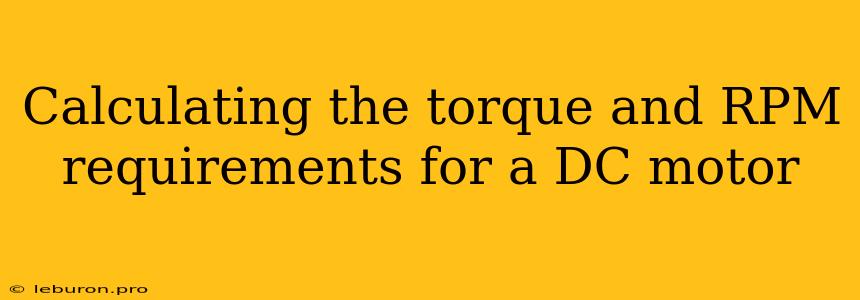Calculating the Torque and RPM Requirements for a DC Motor
Selecting the right DC motor for a specific application requires careful consideration of its operating parameters, particularly torque and RPM (revolutions per minute). These factors determine the motor's ability to deliver the necessary power to drive the load efficiently. This article will provide a comprehensive guide on calculating the torque and RPM requirements for a DC motor, helping you choose the most suitable motor for your project.
Understanding Torque and RPM
Torque is the rotational force that a motor can generate. It is measured in Newton-meters (Nm) or ounce-inches (oz-in) and represents the motor's ability to overcome resistance and rotate a shaft. RPM (revolutions per minute) describes the motor's rotational speed. It measures how many times the motor shaft completes a full revolution in one minute.
Determining Torque Requirements
To calculate the torque required for your application, you need to consider the following factors:
1. Load Type:
- Inertia: The moment of inertia of the load represents its resistance to change in motion. Heavier loads require more torque to accelerate and decelerate.
- Friction: Friction between moving parts, like bearings or gears, creates resistance that needs to be overcome.
- Gravity: If the load is subject to gravity, it will require additional torque to maintain its position or lift it.
2. Load Characteristics:
- Mass: The mass of the load directly influences the required torque.
- Radius: The distance from the motor shaft to the point where the load is applied (e.g., the radius of a pulley) affects the torque requirement.
- Speed: The desired speed of the load influences the torque needed, especially for acceleration and deceleration.
Calculating Torque
The following formula can be used to calculate the torque required:
Torque (Nm) = (Force (N) × Radius (m)) / Efficiency
Where:
- Force (N) is the force required to move the load.
- Radius (m) is the distance from the motor shaft to the point where the force is applied.
- Efficiency is the efficiency of the system (typically between 0.8 and 0.95).
Example:
Imagine you need to lift a 10 kg object using a pulley with a radius of 0.1 meters. Assuming an efficiency of 0.9, the required torque would be:
Force (N) = Mass (kg) × Gravity (m/s²) = 10 kg × 9.81 m/s² = 98.1 N Torque (Nm) = (98.1 N × 0.1 m) / 0.9 = 10.9 Nm
Determining RPM Requirements
The RPM requirement depends on the desired speed of the load. Consider these factors:
- Application Speed: Determine the required speed of the load in RPM.
- Gear Ratio: If a gearbox is used to reduce or increase the speed, consider the gear ratio.
- Load Dynamics: The load's inertia and friction can affect the necessary RPM.
Calculating RPM
If you know the required load speed and gear ratio, you can calculate the motor's RPM:
Motor RPM = (Load Speed (RPM) × Gear Ratio) / Efficiency
Example:
If the required load speed is 100 RPM and you are using a gearbox with a gear ratio of 10:1, with an efficiency of 0.9, the motor's RPM would be:
Motor RPM = (100 RPM × 10) / 0.9 = 1111.11 RPM
Selecting the Right DC Motor
Once you have calculated the required torque and RPM, you can select a DC motor that meets or exceeds those specifications. Consider these factors:
- Motor Torque Rating: The motor should have a torque rating that is greater than or equal to the calculated torque requirement.
- Motor RPM Rating: The motor's maximum RPM should be sufficient for the application, taking into account any gear ratios.
- Voltage and Current Requirements: Ensure the motor's voltage and current specifications match the available power supply.
- Motor Size and Weight: Choose a motor that fits the available space and weight restrictions.
Conclusion
Calculating the torque and RPM requirements for a DC motor is crucial for selecting the right motor for your application. By carefully considering the load type, load characteristics, and desired speed, you can determine the necessary torque and RPM to ensure the motor efficiently drives your project. Always choose a motor with specifications that meet or exceed your calculated requirements for optimal performance and longevity.
